Yellen Again Rejects Trillion Dollar Coin
A silly workaround to an infuriating problem that won't go away.
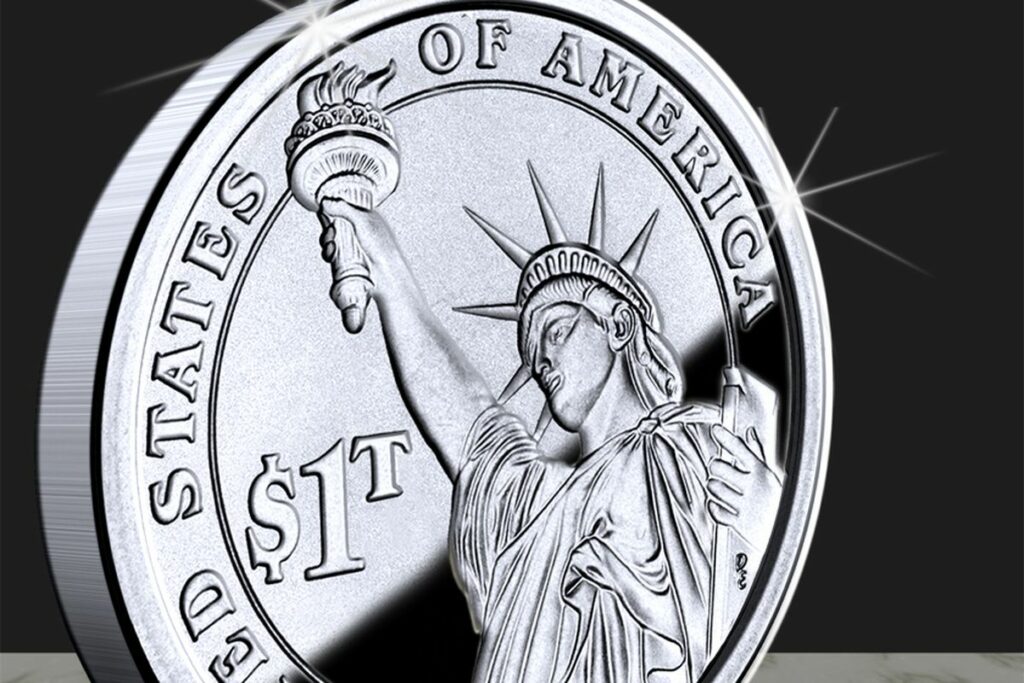
WSJ (“Janet Yellen Dismisses Minting $1 Trillion Coin to Avoid Default“):
Treasury Secretary Janet Yellen said the Federal Reserve likely wouldn’t accept a $1 trillion platinum coin if the Biden administration tried to mint one to avoid breaching the debt limit, dismissing an idea that has been floated to circumvent Congress on the issue.
Some Biden administration officials and Democrats on Capitol Hill have discussed the possibility that the Treasury could use an obscure law authorizing platinum coins in the event of a potential default. Under the proposed scheme, the Treasury would mint a $1 trillion coin and deposit it at the Fed, and then draw the money to pay the country’s bills.
Ms. Yellen, who is a former chair of the Fed and meets regularly with current Fed chair Jerome Powell, said the central bank may not go along with such a plan. Fed officials have previously raised concerns about being relied upon to resolve fiscal debates in Congress.
“It truly is not by any means to be taken as a given that the Fed would do it, and I think especially with something that’s a gimmick,” she said in a Sunday interview with The Wall Street Journal onboard an Air Force plane traveling to Lusaka, Zambia, where she is traveling as part of a multicountry tour to bolster U.S.-Africa ties. “The Fed is not required to accept it, there’s no requirement on the part of the Fed. It’s up to them what to do.”
The headline actually belies the content of the article. Yellen doesn’t “dismiss” the idea; she merely thinks it unlikely the Fed would go along with it.
The coin is a zombie solution that won’t go away. Wikipedia provides the backstory:
The idea for the Treasury Department to mint a coin and send it to the Federal Reserve to pay off the debt was first popularized by Populist Party presidential candidate Bo Gritz in 1992. As a standard part of his stump speeches, he would hold up a five-inch example coin. The specific concept was first introduced by Carlos Mucha, a lawyer who commented under the name “beowulf” on various blogs. “Beowulf” outlined the idea in a series of comments on Warren Mosler’s blog in May 2010, noting that “Congress has already delegated to Tsy [Treasury] all the seigniorage power authority it needs to mint a $1 trillion coin”. Beowulf also drew attention to the concept on the blog of economist Brad Delong in July 2010 and in a legal analysis blogpost of his own in January 2011, but it was not until July 2011 that the use of the concept as an unorthodox method of resolving the debt-ceiling crisis came to the attention of the financial press and mainstream media blogs. At that time, the idea found some support from legal academics such as Yale Law School’s Jack Balkin. Once the debt ceiling crisis of the summer of 2011 was resolved, attention to the concept faded.
The concept gained renewed and more mainstream attention by late 2012, as the debt-ceiling limit was being approached again. In early January, the economist Paul Krugman endorsed the idea and asserted that opposition to the idea was coming from people unwilling to admit the truth that “money is a social contrivance”. His endorsement attracted considerable media attention.Former Mint director Diehl was widely cited in the media debunking criticisms of the coin and its basis in law. Congressman Jerry Nadler endorsed the idea,and it was featured in the international press by January 4, 2013.
“Beowulf” would later tell Wired magazine that the coin idea came from a December 2009 Wall Street Journal article that talked about how several people were able to generate frequent-flyer miles at no cost by ordering coins from the U.S. Mint with a credit card offering mileage rewards, then depositing the coins at a bank to pay off the credit card debt. He also said that he was inspired by the 2008 book Web of Debt by Ellen Brown, which quoted a former Treasury official who said the government could order the printing of large coins to pay off the national debt. “Beowulf” said the trillion-dollar coin idea is more rightly attributed to a small discussion group than to an individual, adding that the group was “just in it for the lulz” (i.e., for personal amusement). [footnote references deleted for readability]
So, a silly idea floated three decades ago by a silly man got reincarnated by a blog commenter as One Neat Trick to Solve Our Problems and it caught on with very serious thinkers agreeing that it was a splendid idea.
But it’s obviously absurd. The authority to mint platinum coins is clearly intended for the purpose of issuing collectibles, not circumventing the role of Congress and the central bank. Not only would the Fed quite rightly reject the executive’s creation of one trillllllllion dollars by mere fiat, the courts would surely strike this down as a gross violation of separation of powers.
Back in October 2021, Vox’s Dylan Mathews discussed the idea with Mucha/Beowulf, who argues that the idea wasn’t just to exploit a loophole in the law but an outgrowth of an economic theory:
The idea developed on the forum of Warren Mosler’s website in 2010. Warren is [a] founder of Modern Monetary Theory, which is quite popular among progressives these days. [Modern Monetary Theory, or MMT, is a heterodox school of economics that argues that concerns about the national debt are often overblown.] Anyway, the crowd was brainstorming on how to avoid a default if Congress didn’t lift the debt ceiling and I came across the platinum coin subsection (k) of the Coinage Act.
I blogged about it a bit back then and it was picked up by other bloggers and then journalists and just snowballed from there.
[…]
The best part was getting an email from Phil Diehl, the former Mint director who actually drafted the platinum coin law that Congress enacted in 1997. When he said, “Yes, this will actually work,” I suddenly felt like Rodney Dangerfield in Back to School. He has a Kurt Vonnegut paper due, so naturally he hires Kurt Vonnegut to write it.
It’s hilarious, it was basically an intellectual exercise — like a website where people hash out who the greatest third basemen of all time was or whatever — and it just took off.
Diehl actually likes the idea, having enthusiastically backed it in a 2013 email to Business Insider‘s Joe Weisenthal:
* In minting the platinum coin, the Treasury Secretary would be exercising authority which Congress has granted routinely for more than 220 years. The Secretary’s authority is derived from an Act of Congress (in fact, a GOP Congress) under power expressly granted to Congress in the Constitution (Article 1, Section 8).
* What is unusual about the law (Sec. 5112 of title 31, United States Code) is that it gives the Secretary complete discretion regarding all specifications of the coin, including denominations.
* Moreover, the accounting treatment of the coin is identical to the treatment of all other coins. The Mint strikes the coin, ships it to the Fed, books $1 trillion, and transfers $1 trillion to the treasury’s general fund where it is available to finance government operations just like with proceeds of bond sales or additional tax revenues. The same applies for a quarter dollar.
* Once the debt limit is raised, the Fed ships the coin back to the Mint, the accounting treatment is reversed, and the coin is melted. The coin would never be “issued” or circulated and bonds would not be needed to back the coin.
* There are no negative macroeconomic effects. This works just like additional tax revenue or borrowing under a higher debt limit. In fact, when the debt limit is raised, Treasury would sell more bonds, the $1 trillion dollars would be taken off the books, and the coin would be melted.
* This does not raise the debt limit so it can’t be characterized as circumventing congressional authority over the debt limit. Rather, it delays when the debt limit is reached.
* This preserves congressional authority over the debt limit in a way that reliance on the 14th Amendment would not. It also avoids the protracted court battles the 14th Amendment option would entail and avoids another confrontation with the Roberts Court.
* Any court challenge is likely to be quickly dismissed since (1) authority to mint the coin is firmly rooted in law that itself is grounded in the expressed constitutional powers of Congress, (2) Treasury has routinely exercised this authority since the birth of the republic, and (3) the accounting treatment of the coin is entirely routine.
* Yes, this is an unintended consequence of the platinum coin bill, but how many other pieces of legislation have had unintended consequences? Most, I’d guess.
Interestingly, even Mucha doesn’t really think it’s a great idea.
At the same time as I started noodling around on platinum coinage, I found and wrote about two other loopholes too:
- Treasury can issue perpetual consols [debts that never mature and continue paying interest forever until the government buys them back]. Since there’s no guarantee to repay the principal, it doesn’t add to public debt (which measures amount of guaranteed principal).
- The Fed can just donate the Treasury securities it holds back to Treasury.
Of the three [the above two and the coin], issuing consols is probably the least disruptive. Treasury can announce it is issuing T-bonds “payable at the pleasure of the United States” instead of a fixed term and can hold an auction later the same day. So that’s what I’d expect to see if Treasury runs out of money.
The last time the idea was floated, back in October 2021, Yellen was more adamant:
White House officials have circulated memos with a range of theories of what to do if Congress does not raise or suspend the debt ceiling. The $1 trillion coin was among the options included in those memos, The Washington Post reported earlier this month, but administration officials dismissed it as unworkable. The majority of Democrats in Congress appear to agree, but Reps. Jerrold Nadler (D-N.Y.) and Rashida Tlaib (D-Mich.) have both advocated for the coin.
But Yellen told CNBC that the coin was a bad idea.
“I’m opposed to it and I don’t think we should consider it seriously. It’s really a gimmick and what’s necessary is for Congress to show that the world can count on America paying its debts,” Yellen said.
“This is equivalent — the platinum coin is equivalent to asking the Federal Reserve to print money to cover deficits that Congress is unwilling to cover by issuing debt. It compromises the independence of the Fed, conflating monetary and fiscal policy,” she said. “And instead of showing that Congress and the administration can be trusted to pay the country’s bills, it really does the opposite.”
Policymakers at the time came up with the same conclusion as Mucha:
The easiest thing would be for Congress to raise the debt ceiling, but Senate Republicans insist that Democrats must raise it on their own, without any Republican help. Raising or suspending the debt limit requires 60 votes in the Senate to defeat a filibuster. That means 10 Republicans need to vote with Democrats on the measure. But Republicans are blocking Democrats from proceeding.
Another alternative under consideration is for President Biden to simply keep borrowing money and paying the country’s bills even if the government is not supposed to take on more debt, The Post reported last week. The debt ceiling, some legal scholars claim, conflicts with the 14th Amendment of the Constitution. Section 4 of the amendment states: “The validity of the public debt of the United States … shall not be questioned.”
In other words, it is simply unconstitutional for the United States to default on its debt. However, it is also unconstitutional for the president to defy a law passed by Congress.
“They would have two choices — each of which is unconstitutional,” one of the people aware of the administration’s discussions said. “This is the theory of the ‘less constitutional choice’: If the president did this it would violate the Constitution, but to not do it would violate the Constitution even more seriously.”
This argument has been raised several times by OTB commenters, notably @Stormy Dragon. I’m skeptical of this expansive view of the Debt Clause, in that paying debts is not a requirement, much less an authorization, to take on more debt. And, to the extent the President has an obligation to spend money passed in Congressional budgets, it’s statutory and there’s another statute—the debt ceiling—in conflict.
The most likely alternative is the one that’s been used every time the game has been played: a negotiated settlement with Congressional Republicans. It’s frustrating to be held hostage in this way, to be sure, but it’s likely the best of bad options.

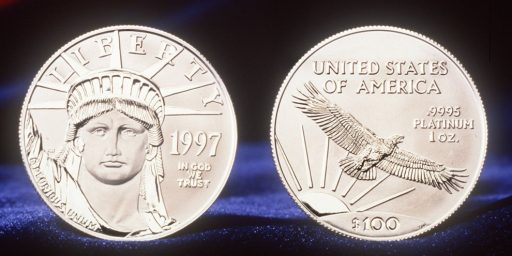
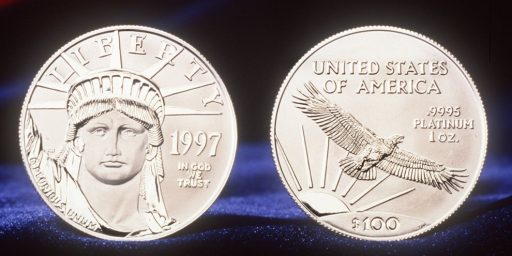
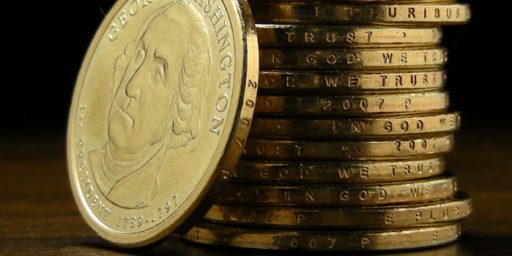
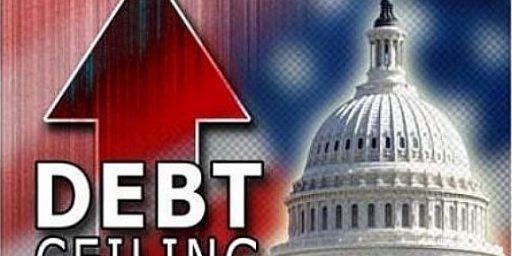
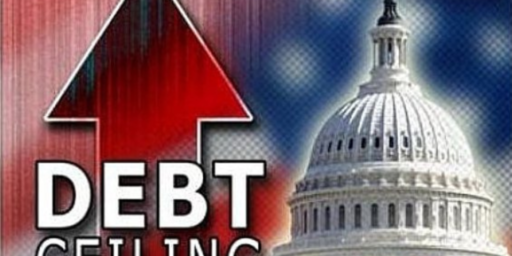
Setting aside if the Trillion Dollar Coin is a good idea or not, issuing it is not taking on new debt.
How about a trillion dollar crypto coin? Trendy.
@Jon: Right. Different argument.
Dear Chairman Powell, you seem to have two options: One, destroy the full faith and credit of the United States along with the world’s financial system. Or two, accept for deposit the enclosed One Trillion Dollar coin. Let us know by Tuesday. Yours, Janet.
Are we really sure the Fed wouldn’t go along with this?
The whole situation is absurd. The existence of the Debt Limit is an absurd anachronism from WWI. Negotiating with the idiots in the GOP caucus was absurd when McCarthy did it and would be more absurd for Biden to do it over the budget. Allowing minority rule to weaken or destroy SS would be absurd. If we got the world to accept the coin idea, these idiots would lose their leverage and we wouldn’t have to do it. Why single out the coin for criticism?
Yes, the $1 trillion coin is absurd.
The debt limit is also absurd.
And while I really don’t think that the $1 trillion coin should be minted, part of me is to the point that I am down with it.
The debt limit should be abolished and Congress should take ownership of spending during the budget process, where such issues are logically contained.
Moreover, I would take the GOP more seriously on debt questions if they showed so much as an iota of concern when they have control of Congress.
@Steven L. Taylor: By a general reading, the debt limit would seem to be an internal contradiction with authorised spending and issuances, and logically should not be constitutional – although given your current Court, proper logical both Common law and general is perhaps dangerous to assume.
@gVOR08: Because it is a silly response .
What if the debt limit is raised net time to “all the money on Earth”? That should cover any debt needs for the rest of Biden’s terms.
How exactly is the Trillion dollar coin gambit materially different the quantitative easing that the Fed does whenever they like?
Question (probably a dumb one): How is minting a trillion dollar coin different from printing 10 billion $100 bills?
@MarkedMan:
What’s readily apparent is the coin won’t circulate. No one can make change for it.
Besides, that’s too many bills. how about 100,000 $10,000 bills?
@Rick DeMent: It is different by being entirely unrelated in either mechanics or basis.
There is no particular legal basis to question either the basis of QE being fundamental to central bank operational mandates since modern central banking.
Excepting weirdo libertarians with a pathological ideological stance against government and government currencies that are not either primitive metallic fetish items or bizarre computer scams, no one seriously questions QE basis (appropriateness, wiseness, yes, banking basis).
By reading the coin concept is at best a strained reading of a text not meant for purpose.
It is rather better – abstracting again away from your rather quesitonable current Supreme Court – to attack the constitutionality (as really it is inherently nonsensical for the legislature to authorise spending, to be bound by a constitutional mandate to respect the full faith and credit, and to self-impose a limit to mechanically authorise debt that by any financial logic violates the self same mandate and contradicts its own funding decision)
However in the world of the realistic, if this is correct, that Treasury can get around by issuance of perpetual consols [for which the accuracy needs proper legal basis analysis of course]
“Treasury can issue perpetual consols [debts that never mature and continue paying interest forever until the government buys them back]. Since there’s no guarantee to repay the principal, it doesn’t add to public debt (which measures amount of guaranteed principal).”
this is a far better check-mate than the coin idea as more fully under the control of the Treasury avoiding a rejection risk, although there is a market risk as the bond market has to absorb.
But it is a classic and even ancient Common Law instrument. And once executed while on one hand opens some dangerous potential paths (however in the end fiscal rectitude depends on custom and practice, so…) it on the other hand would utterly empty the hostage taking over debt ceiling of meaning.
@Kathy: That’s an interesting thought. The US government actually printed $100K bills, but they were only used for transactions between federal reserves (or something like that). Maybe forget the coin and just do 10,000 $100,000 bills? No question those are authorized. If we still have the plates, the printing presses are essentially the same as they were in 1934 when that bill was last printed.
Years ago I did a lot of consulting for the US Bureau of Engraving and Printing and would pass two of them on display in a frame (front and back) whenever I went to the cafeteria. The frame contained front and back of every bill ever printed there and by the time you got the oddballs ($500, $1000, $5000 and $10,000 as well as those $100K notes) and added in silver certificate versions, there were a lot of bills up there.
@Lounsbury: Have to admit that I often just stop reading when you go into insult mode, but also have to admit I enjoyed this:
@Lounsbury:
And in this one sentence, you may well have done the best explanation of the problems of Critical Legal Theory evah.
I see two potential problems with the coin idea and that it would make the debt ceiling irrelevant. First, the intent of the ploy (and it is a ploy, very clearly) is that the coin will be taken back and melted when the debt limit is raised and there’s new borrowing to cover the value of the coin. It hasn’t eliminated the relevancy of the debt ceiling at all, it’s just another “kick the can” variation.
Second, there may be downstream effects on the national and global economy should the
G![ETA:] GQP continue to refuse to raise the debt ceiling. Briefly: How many times can we do the Trillion bux coin trick? Because we’re likely to need to do in in about another 9-13 months. I see the same potential problem with perpetual consoles. The possibility of having 10 or 15 trillion in perpetual consoles may well make our economic system look more like a ponzi scheme than an government budget system.ETAA: Never bet against the ability of innumerate idiots to continue an economic crisis. The GQP House Caucus isn’t just gonna say “Well, I guess we lost; we might as well eliminate the debt ceiling” no matter how hard we believe in Tinkerbell.
@MarkedMan:
How about that? I’d been under the mistaken impression the largest US note ever printed was the $10,000 one. That’s why I suggested it.
I try not to get involved in monetary policy. It’s messy and not in a good way.
I would like Biden to commission the design of the $1T coin, if only as an opening gambit for the Republican’s “Let’s Hold The Economy Hostage” demands.
As stupid as the coin is, it is less stupid than defaulting on the debt.
Also the coin should have Air Bud on it.
@MarkedMan: My understanding is that the law allows the treasury to mint platinum coins without approval of congress, but not paper currency. It is expected that these would be ceremonial coins of nominal value, but that is not specified.
As an overly literal person (textualist?), I approve. It may not have been the intent of the congress that passed the law, but it is there. There’s no “words have changed meaning” argument that you might have with the constitution, this is the equivalent of congress passing a law that they intended to apply to “fish, eggs and ham” but forgetting a comma and applying it to ham and caviar. Sucks to be you, congress, go fix the law if it bothers you so much.
Further, as it has been discussed for several years and congress has chosen not to change the law to fix the text, I think we can say that the legislature accepts this reading. At a certain point inaction is a deliberate choice.
@Just nutha ignint cracker: I do grant your critique on the perpetuals as fundamental check-mate as indeed there is a bond-market risk there, and given the madness that has infected the Republican Party, the repeated recourse to perpetuals is indeed something with real embedded risk.
On other hand as a resolution, it at least unlike the coin concept, has (presuming the legal observation from the article is in fact correct and well-founded, a fundamental point which might not be correct) at least proper foundation in normal order operations as well as even domestic US precedent, albeit somewhat archaic. Versus the coin which is a pure gimmick.
Barring a Supreme Court change for less extremist ideological balance, this may be (again presuming the legal foundation is in fact valid) the available path.
@MarkedMan: panache.
If we are going to do a silly trillion-dollar coin, then I want to do it only once and take the political hit only once. That means a trillion is not enough – we need to mint a 500 trillion dollar coin, and we need to mint 10000 of them.